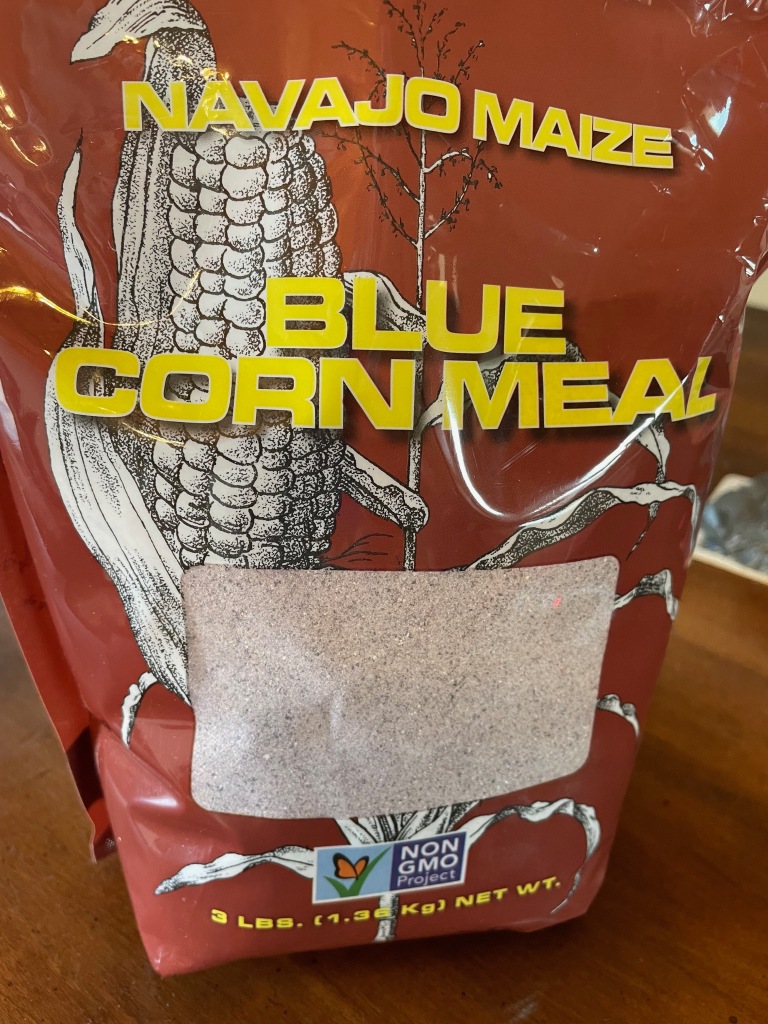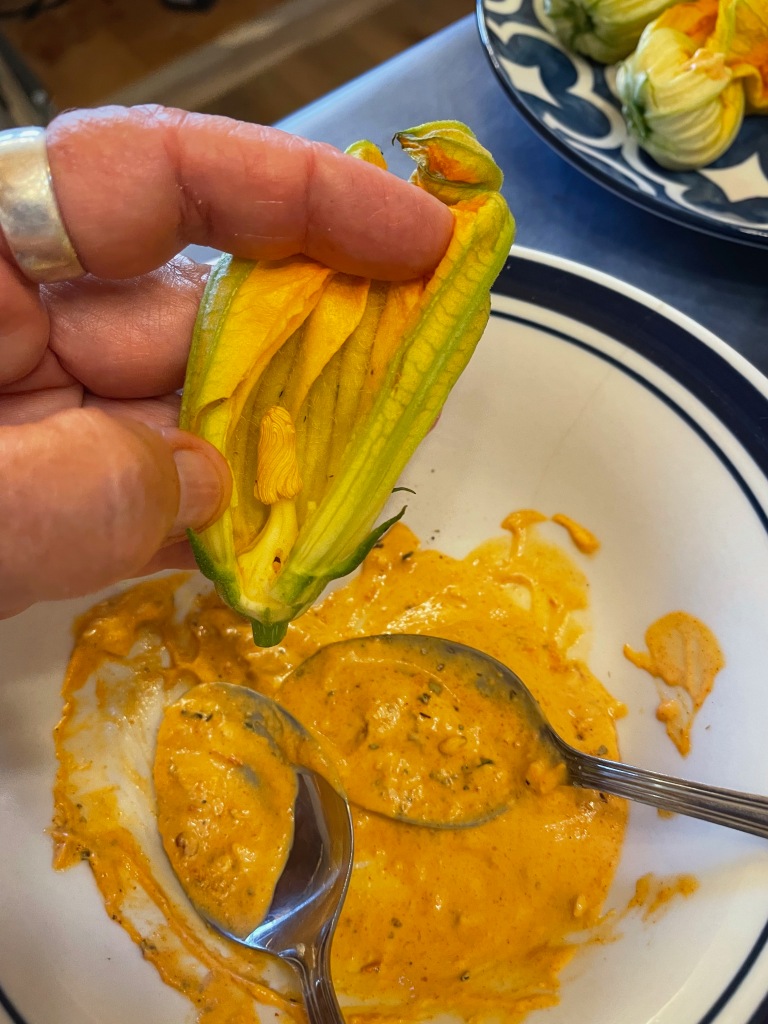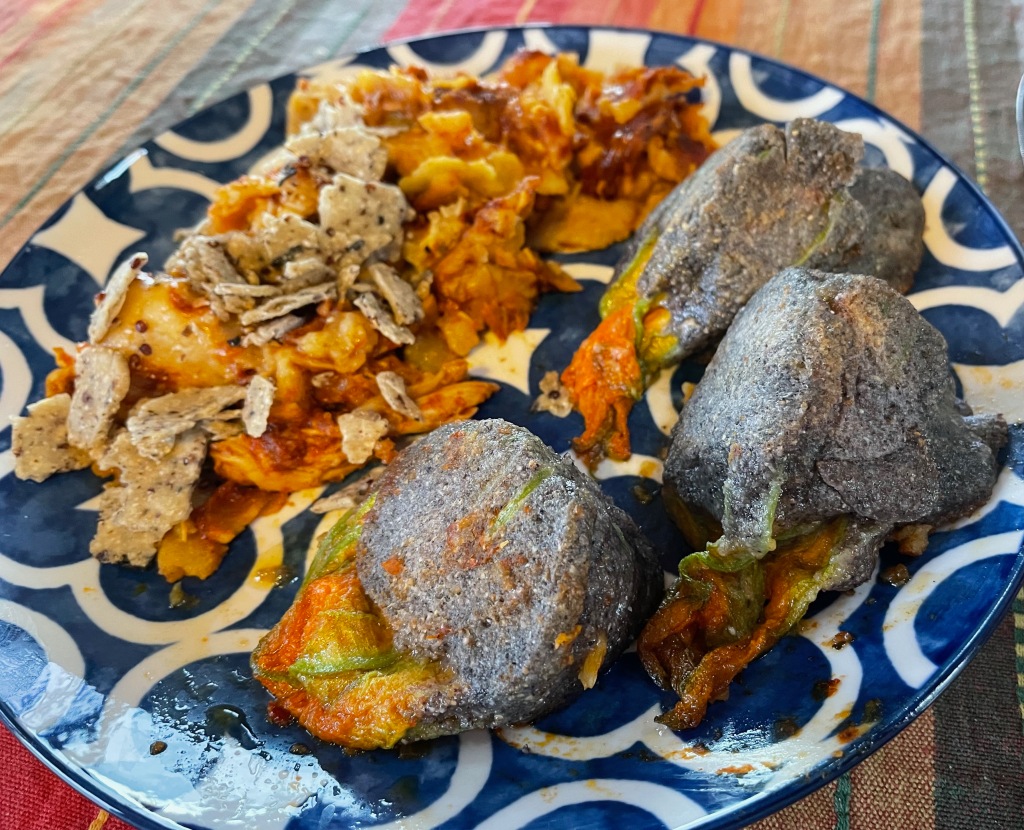
Squash vines absolutely LOVE this monsoon-season humidity! If you’re growing squash this late-summer season–or if you know anyone who is–now is the time to harvest for the rare and wonderful treat of stuffed squash blossoms! I was inspired by a fantastic meal in Winslow, Arizona, at the Turquoise Room in the lovely old La Posada Hotel, by the SP Railroad and historic Rt.66. The chef there served batter-fried squash blossoms to die for! Tia Marta here to share some experimental ideas for going SW-Gourmet in this short season.

The glorious flower image above is from NativeSeedsSEARCH’s heirloom Magdalena Big Cheese squash grown out at Mission Garden.
Image to left: Hiding under that green cloak of giant spotted leaves of this year’s Tohono O’odham HA:L (growing in the Hohokam-period Timeline Garden at Mission Garden) you might find male flowers, then later, female flowers
.

Knowing the difference between male and female flowers is really important! You can tell them apart because the female flowers, which usually appear later on the vines, have a bulbous base below the fused petals which will become the fruit. Keep the female flowers protected on the plant! You can actually aid and abet pollination by “playing bee”–by cutting off male flowers to hand pollinate the stigma of the female flowers. Then–tah dah!–instead of throwing that male flower in the compost, take it to the kitchen to prep some fun hors d’oevres!

Squash flowers are so sculptural, even animate with a jaunty twist to the petals. These male flowers are washed and ready to stuff!

Gently slice open one side of each male flower vertically “with the grain”. The thick yellow pollen-covered anther will be visible.

For this stuffing, I mixed blue cheese with enough cream cheese as a binder and added garlic, dried basil, pimenton, and a touch of sea salt. I spooned the mixture into the “cavity” of the flower calyx.

I then carefully closed the petals and sepals together….

….and simply sauteed them in butter on all sides. The cheese stuffing melted slightly. I served them with toasted Barrio Bread cut melba-thin, and oh my, what a delicacy!

With a new harvest of squash flowers at a later occasion, I decided to try a batter-blossom. I found fabulous Navajo blue cornmeal and made a simple batter with one fresh egg beaten with a generous pinch of sea salt and 1/3 cup cornmeal. (I didn’t add milk but you could if you want a thinner batter.)

This time I made a chilpotle and cheese stuffing mix: Melt a 1/2 cup of any good grated Mexican cheese and lace with a 1/4 tsp chilpotle flakes or chilpotle powder to taste. I added garlic salt, and pinches of dry Mexican oregano and parsley leaf…..and mixed it to the consistency of a thick dip. I
I spooned the cheese mix again into the open flower cavity and, holding the stuffed closed flower by the petal ends, I dipped each into the blue cornmeal batter….

…..so that 3/4 of each stuffed flower was covered with the batter. I then sauteed these little gems in lots (2 tbsp+) butter on 3 sides….

….and served them with enchiladas. What a surprise–They looked like little baby tortoises! And oh they were SO tasty, with a crunch on the outside and a hot spicy, creamy center.
Tia marta hoping you enjoy your late summer in a garden–perhaps with a visit to Tucson’s amazing Mission Garden–exploring for squash blossoms with which to invent new recipes! And do let me know of your successes!
Plan now for next year’s monsoon garden, Tohono O’odham-style. Seeds for many delicious time-and-temperature-tested local squash varieties are available from NativeSeedsSEARCH and Mission Garden. Next summer, have your garden plot ready to put your seeds in the ground with a song when monsoon clouds begin to form. That’s when the O’odham know the squash will be happiest and perform the best.




































